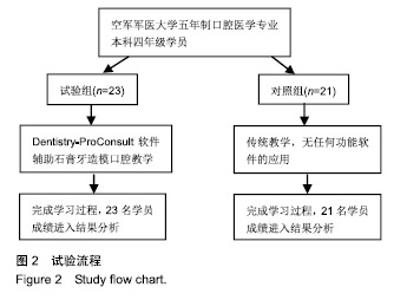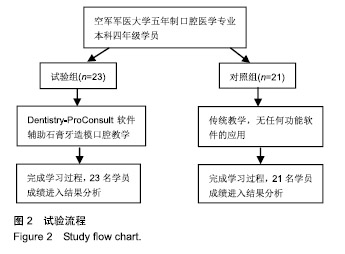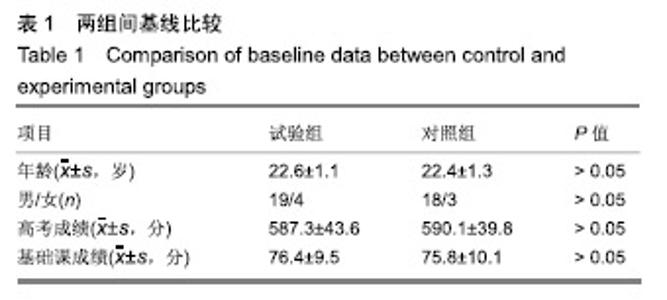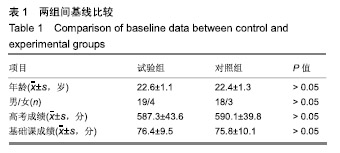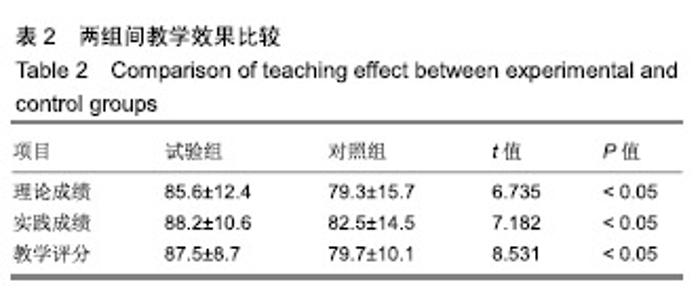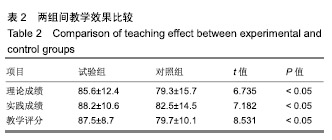Chinese Journal of Tissue Engineering Research ›› 2019, Vol. 23 ›› Issue (30): 4811-4815.doi: 10.3969/j.issn.2095-4344.1410
Previous Articles Next Articles
Application of Dentistry-ProConsult software to assist plaster tooth modeling in stomatology teaching
- 1State Key Laboratory of Military Stomatology & National Clinical Research Center for Oral Diseases & Shaanxi Key Laboratory of Stomatology, Department of Oral Anatomy and Physiology, School of Stomatology, The Fourth Military Medical University, Xi’an 710032, Shaanxi Province, China; 2Department of Orthopedics, Xijing Hospital, Air Force Medical University, Xi’an 710032, Shaanxi Province, China
-
Received:2019-04-20Online:2019-10-28Published:2019-10-28 -
About author:Lu Lei, MD, Lecturer, State Key Laboratory of Military Stomatology & National Clinical Research Center for Oral Diseases & Shaanxi Key Laboratory of Stomatology, Department of Oral Anatomy and Physiology, School of Stomatology, Air Force Medical University, Xi’an 710032, Shaanxi Province, China -
Supported by:the National Natural Science Foundation of China, No. 81672148 (to HJH); Medical Education Branch of Chinese Medical Association and Medical Education Research Program of Medical Education Committee of China Higher Education Association, No. 2018B-N02186 (to YSB)
CLC Number:
Cite this article
Lu Lei, Yu Shibin, Shi Xiaowei, Ma Teng, Huang Jinghui, Yang Hongxu. Application of Dentistry-ProConsult software to assist plaster tooth modeling in stomatology teaching[J]. Chinese Journal of Tissue Engineering Research, 2019, 23(30): 4811-4815.
share this article
| [1]Bakr MM, Thompson CM, Massadiq M.Anatomical sciences: A foundation for a solid learning experience in dental technology and dental prosthetics.Anat Sci Educ. 2017;10:395-404.[2]易新,李波,刘纯义.浅谈口腔解剖生理学教学[J].解剖科学进展, 2017,23(6):658-659.[3]莘晓陶,程嘉泽.以器官系统为中心的口腔解剖与生理学在留学生教学改革的探究[J].中国继续医学教育,2017,27(9):7-9.[4]邓晓慧,孙春莉,付升旗,等.口腔解剖生理学实验课教学改革尝试[J].四川解剖学杂志,2016,24(1):46-47.[5]Katona TR, Eckert GJ. The mechanics of dental occlusion and disclusion. Clin Biomech. 2017; 50: 84-91[6]毕振宇,刘阳,欧阳钧.口腔解剖生理学教学中专业素质的培养[J].基础医学教育,2014,16(11):900-902.[7]贺建军,焦凯,牛丽娜,等.《口腔解剖生理学》教学中提高学生科研兴趣与素养之初探[J].牙体牙髓牙周病学杂志, 2014,24(9): 558-560.[8]de Azevedo RA, Correa MB, Torriani MA,et al. Optimizing quality of dental carving by preclinical dental students through anatomy theory reinforcement. Anat Sci Educ.2018;11: 377-384.[9]Al-Thobity AM, Farooq I, Khan SQ. Effect of software facilitated teaching on final grades of dental students in a dental morphology course.Saudi Med J.2017;38:192-195.[10]Cendán JC, Castiglioni A, Johnson TR. Quantitative and Qualitative Analysis of the Impact of Adoption of a Mobile Application for the Assessment of Professionalism in Medical Trainees. Acad Med.2017;92:S33-S42.[11]Lone M, McKenna JP, Cryan JF,et al. A Survey of tooth morphology teaching methods employed in the United Kingdom and Ireland. Eur J Dent Educ. 2018;22(3):e438-e443. [12]Abu Eid R, Ewan K, Foley J,et al. Self-directed study and carving tooth models for learning tooth morphology: perceptions of students at the University of Aberdeen, Scotland. J Dent Educ. 2013;77(9):1147-1153.[13]Holden A, Dracopoulos SA.Owning the tooth: exploring the ethical and legal issues relating to the use of extracted human teeth in dental education in Australia. Aust Dent J. 2017;62(2): 146-151. [14]Licari FW, Evans CA. Clinical and Community-Based Education in U.S. Dental Schools. J Dent Educ. 2017; 81(8): eS81-eS87.[15]Slavkin HC. The Impact of Research on the Future of Dental Education: How Research and Innovation Shape Dental Education and the Dental Profession.J Dent Educ. 2017;81(9): eS108-eS127.[16]Nayak MT, Sahni P, Singhvi A, et al. The perceived relevance of tooth carving in dental education: Views of practicing dentists and faculty in West India. Educ Health (Abingdon). 2014;27(3): 238-242. [17]de Boer IR, Wesselink PR, Vervoorn JM. The creation of virtual teeth with and without tooth pathology for a virtual learning environment in dental education. Eur J Dent Educ. 2013; 17(4): 191-197. [18]Hey J, Schweyen R, Kupfer P,et al.Influence of preparation design on the quality of tooth preparation in preclinical dental education.J Dent Sci.2017;12(1):27-32. [19]Joda T, Gallucci GO,Wismeijer D,et al. Augmented and virtual reality in dental medicine: A systematic review.Comput Biol Med.2019;108:93-100.[20]Andrews EA.The Future of Interprofessional Education and Practice for Dentists and Dental Education.J Dent Educ. 2017; 81(8):eS186-eS192. [21]Al-Rawi W,Easterling L,Edwards PC. Development of a mobile device optimized cross platform-compatible oral pathology and radiology spaced repetition system for dental education. J Dent Educ.2015;79(4):439-447.[22]Perry S,Burrow MF,Leung WK,et al.Simulation and curriculum design: a global survey in dental education. Aust Dent J. 2017; 62(4):453-463. [23]Sly MM,Barros JA,Streckfus CF,et al.Grading Class I Preparations in Preclinical Dental Education: E4D Compare Software vs. the Traditional Standard.J Dent Educ. 2017; 81(12):1457-1462. [24]Kishimoto N,Mukai N,Honda Y,et al. Simulation training for medical emergencies in the dental setting using an inexpensive software application. Eur J Dent Educ. 2018;22(3):e350-e357. [25]Al-Thobity AM, Farooq I,Khan SQ. Effect of software facilitated teaching on final grades of dental students in a dental morphology course.Saudi Med J.2017;38(2):192-195. [26]Garrett PH,Faraone KL,Patzelt SB,et al.Comparison of Dental Students' Self-Directed, Faculty, and Software-Based Assessments of Dental Anatomy Wax-Ups: A Retrospective Study. J Dent Educ. 2015; 79(12):1437-1444.[27]Kateeb ET,Kamal MS,Kadamani AM,et al.Utilising an innovative digital software to grade pre-clinical crown preparation exercise. Eur J Dent Educ. 2017;21(4):220-227.[28]Perry S, Bridges SM, Burrow MF. A review of the use of simulation in dental education. Simul Healthc. 2015;10(1):31-37.[29]Callan RS, Cooper JR, Young NB, et al. Inter- and Intrarater Reliability Using Different Software Versions of E4D Compare in Dental Education. J Dent Educ.2015;79(6):711-718.[30]Mariño R, Ghanim A, Morgan M,et al. Cultural competency and communication skills of dental students: clinical supervisors' perceptions. Eur J Dent Educ. 2017;21(4):e101-e108. [31]Wang D, Li T, Zhang Y,et al.Survey on multisensory feedback virtual reality dental training systems.Eur J Dent Educ. 2016; 20(4):248-260. [32]Sipiyaruk K, Gallagher JE, Hatzipanagos S, et al. A rapid review of serious games: From healthcare education to dental education. Eur J Dent Educ.2018;22(4):243-257. [33]Park CF, Sheinbaum JM, Tamada Y, et al.Dental Students' Perceptions of Digital Assessment Software for Preclinical Tooth Preparation Exercises. J Dent Educ. 2017;81(5): 597-603.[34]Zitzmann NU, Kovaltschuk I, Lenherr P,et al. Dental Students' Perceptions of Digital and Conventional Impression Techniques: A Randomized Controlled Trial. J Dent Educ. 2017;81(10): 1227-1232.[35]Graham BS, Knight GW, Graham L. Dental Student Academic Integrity in U.S. Dental Schools: Current Status and Recommendations for Enhancement. J Dent Educ. 2016;80(1): 5-13.[36]黄景辉,马腾,罗卓荆.SpineDecide软件在脊柱外科临床实习教学中的应用[J].中国组织工程研究,2014, 18(36):5896-5898. |
| [1] | Chen Ziyang, Pu Rui, Deng Shuang, Yuan Lingyan. Regulatory effect of exosomes on exercise-mediated insulin resistance diseases [J]. Chinese Journal of Tissue Engineering Research, 2021, 25(25): 4089-4094. |
| [2] | Yang Junhui, Luo Jinli, Yuan Xiaoping. Effects of human growth hormone on proliferation and osteogenic differentiation of human periodontal ligament stem cells [J]. Chinese Journal of Tissue Engineering Research, 2021, 25(25): 3956-3961. |
| [3] | Gao Shan, Huang Dongjing, Hong Haiman, Jia Jingqiao, Meng Fei. Comparison on the curative effect of human placenta-derived mesenchymal stem cells and induced islet-like cells in gestational diabetes mellitus rats [J]. Chinese Journal of Tissue Engineering Research, 2021, 25(25): 3981-3987. |
| [4] | Hao Xiaona, Zhang Yingjie, Li Yuyun, Xu Tao. Bone marrow mesenchymal stem cells overexpressing prolyl oligopeptidase on the repair of liver fibrosis in rat models [J]. Chinese Journal of Tissue Engineering Research, 2021, 25(25): 3988-3993. |
| [5] | Liu Jianyou, Jia Zhongwei, Niu Jiawei, Cao Xinjie, Zhang Dong, Wei Jie. A new method for measuring the anteversion angle of the femoral neck by constructing the three-dimensional digital model of the femur [J]. Chinese Journal of Tissue Engineering Research, 2021, 25(24): 3779-3783. |
| [6] | Meng Lingjie, Qian Hui, Sheng Xiaolei, Lu Jianfeng, Huang Jianping, Qi Liangang, Liu Zongbao. Application of three-dimensional printing technology combined with bone cement in minimally invasive treatment of the collapsed Sanders III type of calcaneal fractures [J]. Chinese Journal of Tissue Engineering Research, 2021, 25(24): 3784-3789. |
| [7] | Qian Xuankun, Huang Hefei, Wu Chengcong, Liu Keting, Ou Hua, Zhang Jinpeng, Ren Jing, Wan Jianshan. Computer-assisted navigation combined with minimally invasive transforaminal lumbar interbody fusion for lumbar spondylolisthesis [J]. Chinese Journal of Tissue Engineering Research, 2021, 25(24): 3790-3795. |
| [8] | Hu Jing, Xiang Yang, Ye Chuan, Han Ziji. Three-dimensional printing assisted screw placement and freehand pedicle screw fixation in the treatment of thoracolumbar fractures: 1-year follow-up [J]. Chinese Journal of Tissue Engineering Research, 2021, 25(24): 3804-3809. |
| [9] | Shu Qihang, Liao Yijia, Xue Jingbo, Yan Yiguo, Wang Cheng. Three-dimensional finite element analysis of a new three-dimensional printed porous fusion cage for cervical vertebra [J]. Chinese Journal of Tissue Engineering Research, 2021, 25(24): 3810-3815. |
| [10] | Wang Yihan, Li Yang, Zhang Ling, Zhang Rui, Xu Ruida, Han Xiaofeng, Cheng Guangqi, Wang Weil. Application of three-dimensional visualization technology for digital orthopedics in the reduction and fixation of intertrochanteric fracture [J]. Chinese Journal of Tissue Engineering Research, 2021, 25(24): 3816-3820. |
| [11] | Sun Maji, Wang Qiuan, Zhang Xingchen, Guo Chong, Yuan Feng, Guo Kaijin. Development and biomechanical analysis of a new anterior cervical pedicle screw fixation system [J]. Chinese Journal of Tissue Engineering Research, 2021, 25(24): 3821-3825. |
| [12] | Lin Wang, Wang Yingying, Guo Weizhong, Yuan Cuihua, Xu Shenggui, Zhang Shenshen, Lin Chengshou. Adopting expanded lateral approach to enhance the mechanical stability and knee function for treating posterolateral column fracture of tibial plateau [J]. Chinese Journal of Tissue Engineering Research, 2021, 25(24): 3826-3827. |
| [13] | Zhu Yun, Chen Yu, Qiu Hao, Liu Dun, Jin Guorong, Chen Shimou, Weng Zheng. Finite element analysis for treatment of osteoporotic femoral fracture with far cortical locking screw [J]. Chinese Journal of Tissue Engineering Research, 2021, 25(24): 3832-3837. |
| [14] | Wang Xinting, Xu Dandi, Zhang Junxia, Su Hailong Wang Qi. Stability of load-bearing cross barrier of different arch structures [J]. Chinese Journal of Tissue Engineering Research, 2021, 25(24): 3838-3843. |
| [15] | Zou Shouping, Lu Daoyun, Ye Li. Minimally invasive percutaneous pedicle screw technique for thoracolumbar fractures: biomechanical changes of the spine during 6-month follow-up [J]. Chinese Journal of Tissue Engineering Research, 2021, 25(24): 3865-3869. |
| Viewed | ||||||
|
Full text |
|
|||||
|
Abstract |
|
|||||
